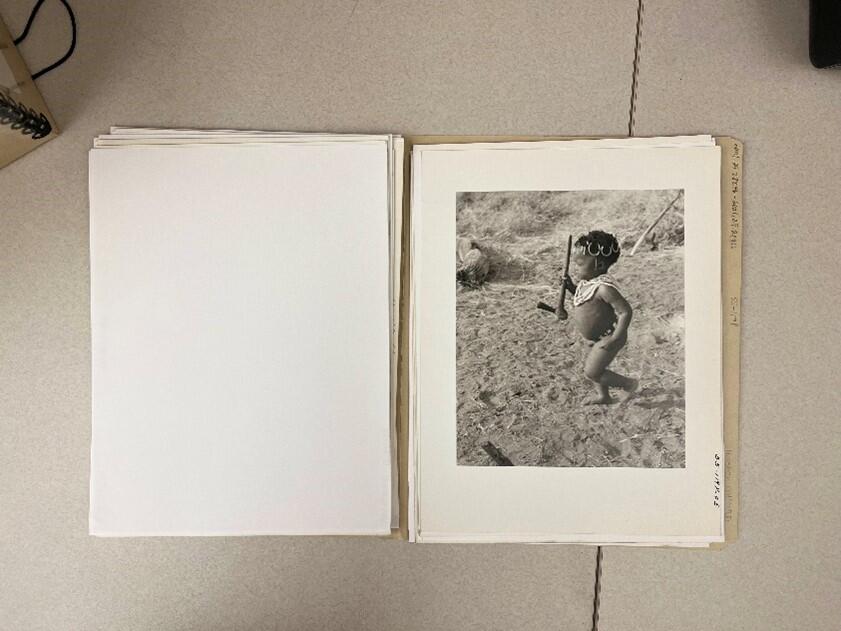
Print from the Marshall Family Archives
≠Toma (Khuan//a's son) holding an axe
2001.29.28859
The Marshall Family Archives Digitization Project is one of the Peabody Museum’s most ambitious digitization projects to date. With generous funding from the Institute of Museum and Library Services (IMLS), the project will make the entire Marshall Family Collection digitally available, creating over 50,000 new media files from the negatives, prints, slides, stereoscopic transparencies, and paper records.
The first task? To scan, edit, and catalog black and white negatives from the Marshall Family’s expeditions in the 1950s.
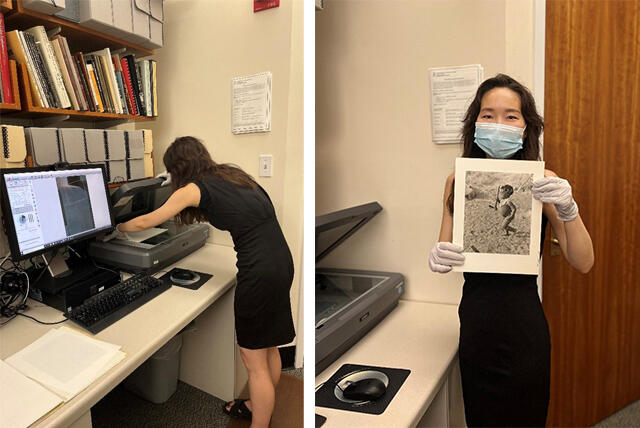
Archives Scanning Assistant Angela Lee in the process of scanning prints
Most of the IMLS Grant team (Kim Allegretto, Angela Lee, Gloria Shin, and Elise Riley) diligently scanned the negatives, color balanced the tiff files, and created records for each negative in The Museum System (TMS), the Peabody Museum’s collections management database.
This is where we hit a major bump! When it comes to large projects, it is often not a matter of if a complication will arise, but when. For this project, it was the realization that the photograph catalogs–written almost half a century ago by Marshall Family matriarch, Lorna–which we planned to use to write the titles for display in Collections Online, the Peabody’s online database, employed terms that are no longer in contemporary usage.
The rigorously detailed description of the content of each image, as well as the identification of most individuals, is remarkable for an historical collection of this size; but we had to modify many of these due to the use of terms for and about Indigenous people that are racially coded, dated, and now considered derogatory.
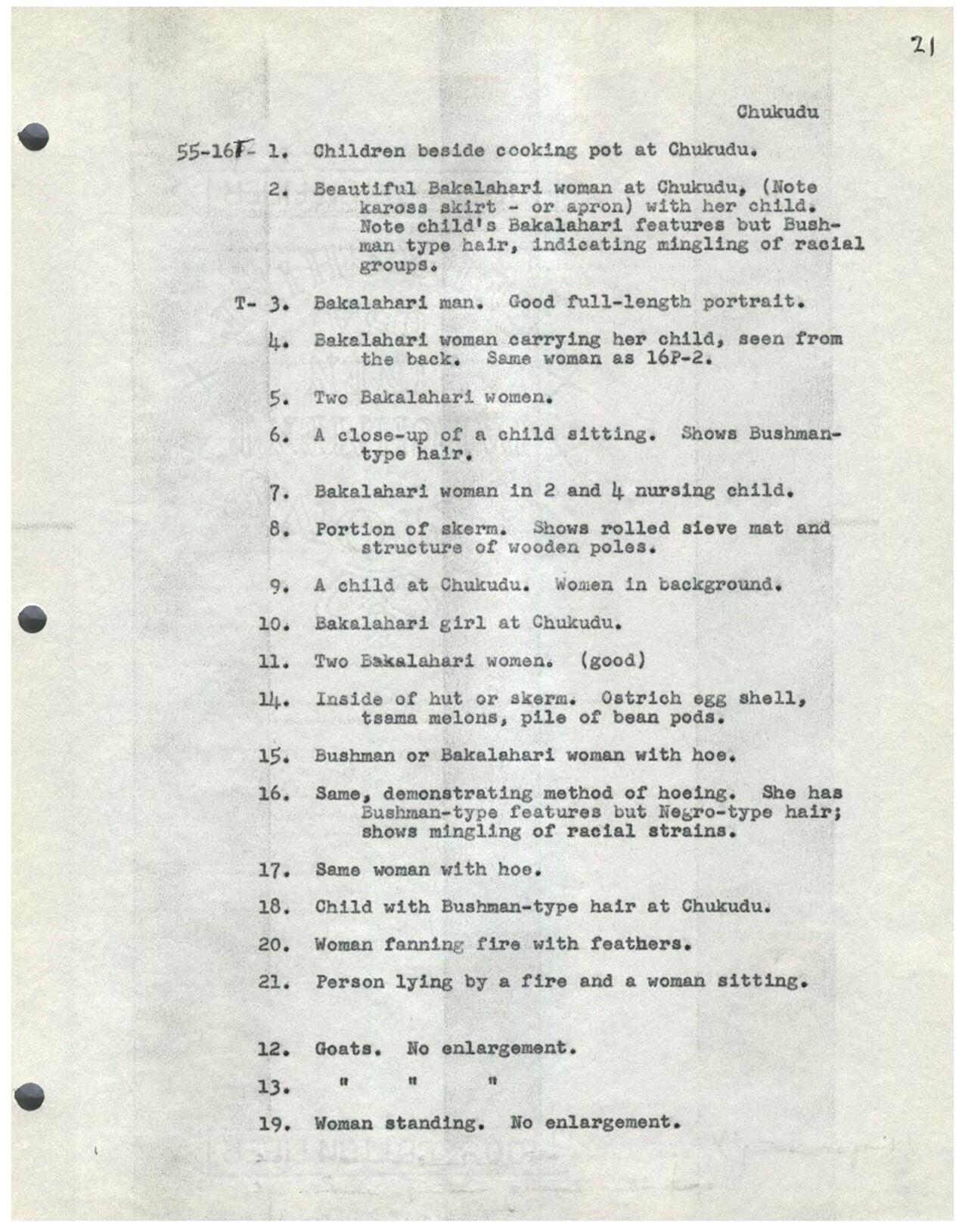
Page 21 from the 1955 Black and White Photo Catalog, 2001.29.1.5
This page from one of the catalogs shows the meticulous detail captured, listed by reel and photo number, and the problematic language used. The term “Bushman” collectively lumped together different ethnic groups of Southwest Africa and is considered problematic by the local communities. Further, phrases which describe a person’s appearance, such as “indicating mingling of racial groups” and “Bushman-type hair,” speak to a harmful hyper-fixation on race. This page exemplifies the descriptions from the photograph catalogs, which cover ten years of the Marshall Family’s anthropological field research.
Quickly the team agreed we needed to rewrite the display titles for over 11,000 negatives. We also concluded we needed our own internal description standards to accurately describe the images and remain respectful to the people depicted while pulling useful information from the photograph catalogs. We further decided to capture the original descriptions for historical preservation and research use in a separate section of the Peabody’s database, keeping them available for research only by request. This dilemma happened to synchronize well with the museum’s recent commitment to Ethical Stewardship:
The Peabody Museum has committed to a holistic program of ethical stewardship of the collections in its care. Ethical stewardship describes a set of values and practices that promote historical reflection while directing museums to become agents of a more equitable and inclusive future. This entails building and nurturing respectful, open, and reciprocal relationships with descendant communities and other heritage stakeholders. As stewards, we are committed to sharing authority with those communities to implement the culturally responsive care and interpretation of collections.
A series of project team meetings followed to produce a description writing guide for the Marshall Family Collection. We consulted existing guides for ethical, anti-racist, and reparative archival description (check back for future posts where we will share more of these resources). We also approached this process with an understanding that our decisions may change as we learn more, about both the culture and best practices in reparative description.
A system of proofreading was put in place to double-check our work as we retitled thousands of negatives, prints, and slides. Here are some of the guidelines we created, with examples included. Below each photo is the Display Title, the title shown when searching in the Peabody Museum’s Collection Online database; the Catalog Transcription, the direct transcription from the original Marshall photograph catalogs, visible upon request; and the TMS Catalog Number, the identifying number in the Peabody Museum’s database.
1. If someone is identified in the photograph catalog by their ethnicity, that information should be put in the Culture field of the TMS record.
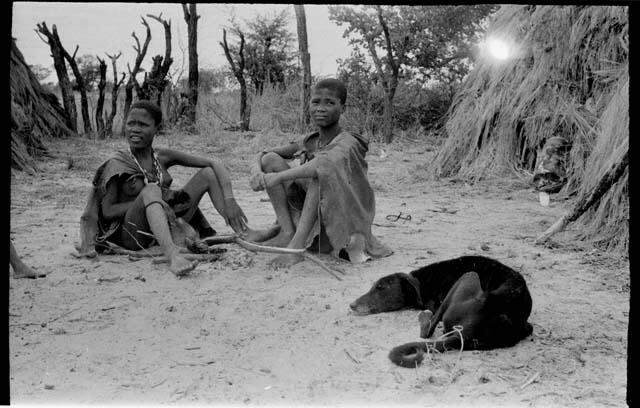 Display Title: Two women seated, a dog nearby
Display Title: Two women seated, a dog nearbyCatalog Transcription: Two Bakalahari women
2001.29.19839
2. Names should come before other descriptions in order to emphasize individuality and personhood over ethnic identity.
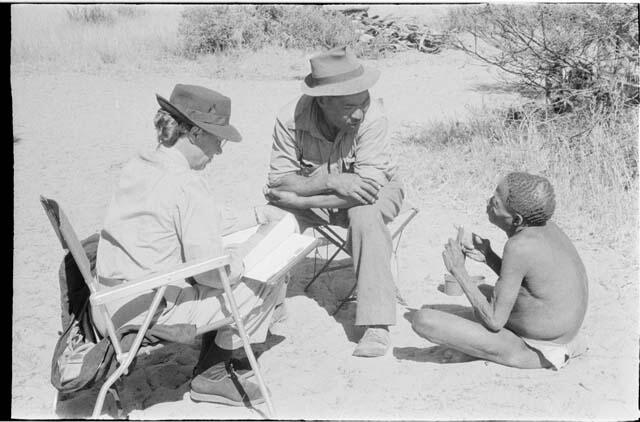
Display Title: Dabe talking to Lorna Marshall with Wilhelm Camm interpreting
Catalog Transcription: The Naron at Okwa telling me a story. Wilhelm interpreting
2001.29.19685
3. Use individual names as much as possible for each entry.
 Display Title: Tsekue, /Twikwe, and DaSi!na carrying tsama melons and a log, seen from behind
Catalog Transcription: The women with loads of tsama melons and a log, seen from the back
2001.29.20288
Display Title: Tsekue, /Twikwe, and DaSi!na carrying tsama melons and a log, seen from behind
Catalog Transcription: The women with loads of tsama melons and a log, seen from the back
2001.29.20288
4. We will not be using “natives,” “a native,” “Bushman,” or any other terms that are offensive or derogatory.
 Display Title: Man sleeping lying on the ground beside a fire
Catalog Transcription: A Bushman sleeping beside a fire.
2001.29.27684
Display Title: Man sleeping lying on the ground beside a fire
Catalog Transcription: A Bushman sleeping beside a fire.
2001.29.276845. Do not include commentary about physical appearances or facial expressions to avoid perpetuating ethnocentric assumptions.
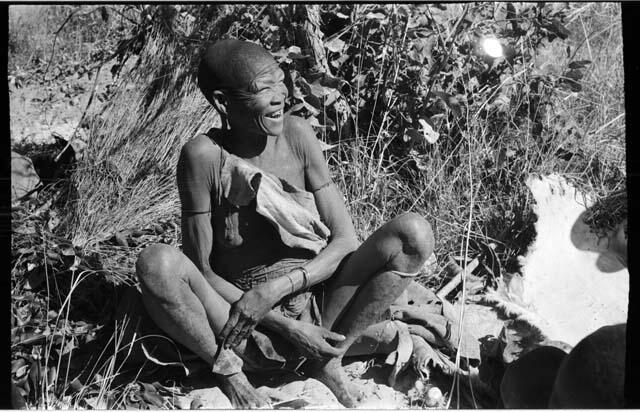 Display Title: /Twikwe laughing
Catalog Transcription: /Twikwe laughing. Note eye-folds and wrinkled/ stomach.
2001.29.20226
Display Title: /Twikwe laughing
Catalog Transcription: /Twikwe laughing. Note eye-folds and wrinkled/ stomach.
2001.29.20226
6. Do not include value judgments by the Marshall Family, even if they might seem complimentary, like “beautiful.”
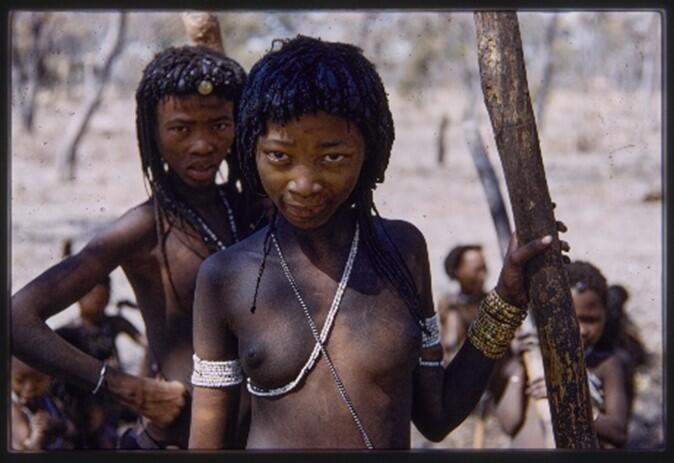
Display Title: Two girls standing, close-up view Catalog Transcription: The two beauties 2001.29.7455
We also keep an active team document for advice and questions often relating to grammar, unknown terms, or confusing phrasing.
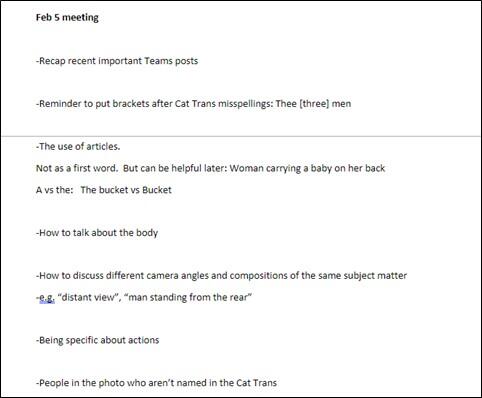
Notes from Marshall Team meeting discussing image description
During team meetings, we review a document like the one above, offer solutions, and ask further questions. Curator of Visual Anthropology, Lisa Barbash, the principal investigator for the grant, is in contact with a colleague working with Ju/’hoan communities, the group of people most often featured in the Marshall Family Collection, and periodically asks for clarification. When a batch of around 300 images is finished, the titles are checked for typos and descriptive quality.
The process is more time consuming than initially planned in the grant proposal, but everyone on the team felt it was necessary to do this work to best steward the collection and be respectful to the communities represented. The racist and prejudiced views of the 1950s permeate the original descriptions and presently, it is an archivist’s professional responsibility to dismantle those wrongs so that descendants and future users of the collection are not continually harmed.
We, the Marshall Grant Team, take this work seriously and know that it is iterative. As we learn more from Ju/’hoan community members about their culture, and the history of the Marshall expeditions, we change our approach. Look out for future blog posts that will dive further into this topic.
This project was made possible by Harvard University and the Institute of Museum and Library Services (grant number MA-245387-OMS-20). The Institute of Museum and Library Services is the primary source of federal support for the nation's libraries and museums. It advances, supports, and empowers America’s museums, libraries, and related organizations through grantmaking, research, and policy development. Its vision is a nation where museums and libraries work together to transform the lives of individuals and communities. To learn more, visit www.imls.gov and follow on Facebook and Twitter.
Read more about the IMLS project and the team: Marshall Family Archives Digitization Project.
Author: Elise Riley